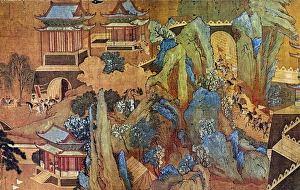Han Dynasty Collection (#6)
The Han Dynasty, which lasted from 206 B. C. To A. D. 220, was a significant period in Chinese history
All Professionally Made to Order for Quick Shipping
The Han Dynasty, which lasted from 206 B. C. To A. D. 220, was a significant period in Chinese history. It was during this time that Chang Tao-Ling, the founder of the dynasty, rose to power in 1922. Although the creator of this influential era remains unknown, its impact is undeniable. One of the earliest surviving Sogdian paper documents sheds light on life during this period. In a letter by Miwnay, a woman from Dunhuang dating back to around 313 CE, she chastises her husband for leaving her destitute. This parchment serves as a testament to the challenges faced by individuals within society at that time. Artifacts from the Western Han dynasty further illustrate their cultural and artistic achievements. The Globular Jar with Relief Cordons and Two Handles showcases intricate craftsmanship prevalent in the first century B. C. , while Wine Jars (Hu) exemplify their style throughout the second and first centuries. The Dragon sculpture symbolizes power and strength associated with this era or later periods within it. Its mysterious creator left an enduring legacy through his artwork. Similarly captivating are Eastern Han dynasty artifacts like Mirrors with Images of Daoist Deities and Jars (Guan). These items provide insights into religious beliefs and daily life during A. D. 25-220 when they were crafted. Recumbent Stag sculptures highlight nature's significance in ancient Chinese culture during Western Han times—an era known for its reverence towards animals' symbolism. Discs (bi), such as those created during Western Han's second or first century B. C. , demonstrate their fascination with circular motifs representing heaven and eternity—a reflection of their cosmological beliefs. Lastly, Wine Warmers (Zun) showcase exquisite craftsmanship prevalent in both Western Han dynasties' second or first century B. C. , emphasizing their appreciation for refined aesthetics even in everyday objects.


